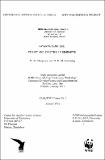| dc.contributor.author | Murphree, M.W. | |
| dc.contributor.author | Cumming, D.H.M. | |
| dc.coverage.spatial | Zimbabwe. | en |
| dc.date.accessioned | 2016-03-14T12:54:44Z | |
| dc.date.available | 2016-03-14T12:54:44Z | |
| dc.date.issued | 1991-01 | |
| dc.identifier.citation | Murphree, M.W. and Cumming, D.H.M. (1991) Savannah land use: policy and practice in Zimbabwe.CASS/WWF Paper no. 1. Harare: CASS. | en |
| dc.identifier.uri | https://opendocs.ids.ac.uk/opendocs/handle/20.500.12413/10021 | |
| dc.description | A conference presented at the IUBS UESCO/UNEP conference workshop on: Economic Driving Forces And Constraints On Savanna Land Use, Nairobi, Kenya, January 1991. | en |
| dc.description.abstract | Zimbabwe is situated on the high plateau of east and Southern Africa and lies wholly within the tropics. There are four main physiographic regions with the eastern mountains forming a narrow band along the Mozambique border. The rest of the country is characterised by the north-east to south-west watershed - the "highveld" which lies above 1200m and which descends to the Zambezi River in the north and the Limpopo River in the southeast via a scries of plateaux, with the middle veld (900-1200m) giving way to the lowveld (below 900m). The soils are mainly derived from the ancient basement complex underlying the continent and are consequently infertile. Apart from high rainfall areas of the eastern highlands the country is predominantly wooded savanna with a mean annual rainfall of between 400 an I 1200 mm per annum with some 65% of the country receiving less than 750mm per annum. The moister, north . astern sector, is able to support commercial farming based on cash and food crops and beef production. An equable tropical climate conferred by its altitude (about 66% lies above 900m) and the promise of high agricultural potential resulted in a relatively large, for an African colony, immigrant white population. This unusual situation lead to early self governing colonial status, an entrenched dual land use system (Figs. 1 and 2), a dual agricultural economy, and delayed political independence. Within this framework we examine the developing political economy of Zimbabwe and its impact on changing land use patterns and savanna ecology.
This chapter identifies the principal components which have shaped contemporary savanna land use policy and practice in Zimbabwe and provides policy recommendations of national and international relevance. | en |
| dc.description.sponsorship | IUBS -UNESCO / UNEP | en |
| dc.language.iso | en | en |
| dc.publisher | Centre for Applied Social Sciences (CASS); University of Zimbabwe (UZ) | en |
| dc.relation.ispartofseries | CASS/WWF Paper;1 | |
| dc.rights.uri | http://creativecommons.org/licenses/by-nc-nd/3.0/ | en |
| dc.subject | Development Policy | en |
| dc.subject | Environment | en |
| dc.title | Savannah land use: policy and practice in Zimbabwe | en |
| dc.type | Conference paper | en |
| dc.rights.holder | University of Zimbabwe (UZ) | en |


